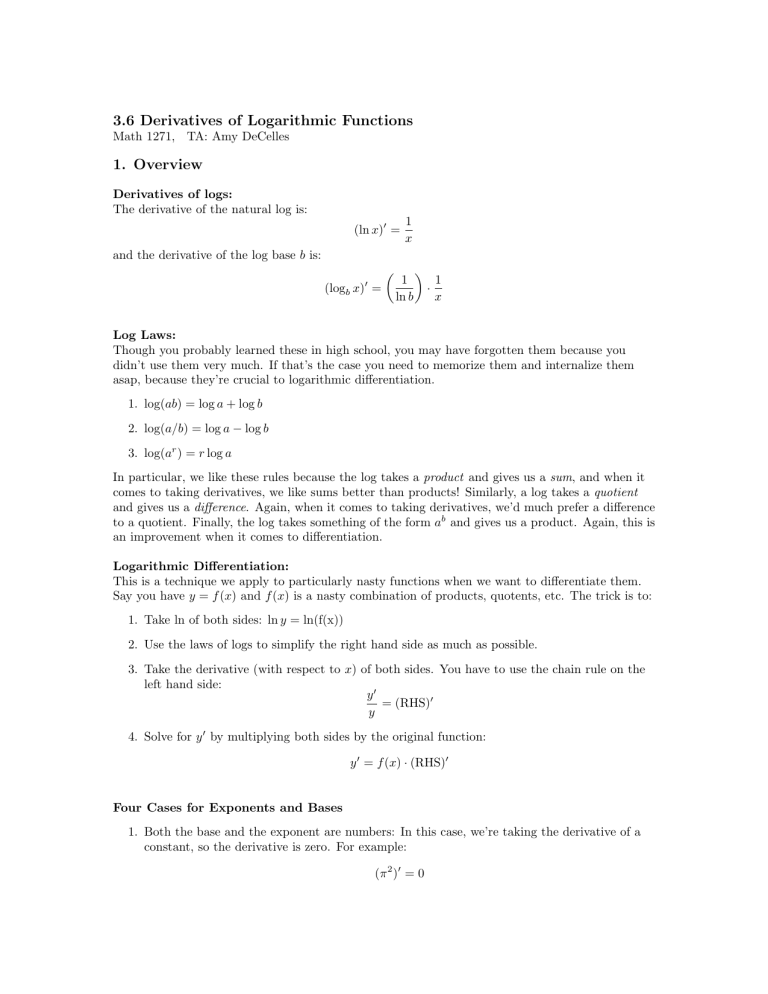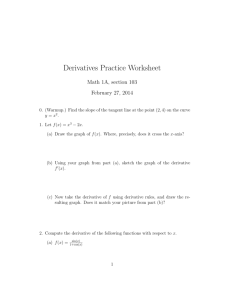3.6 Derivatives of Logarithmic Functions 1. Overview

3.6 Derivatives of Logarithmic Functions
Math 1271, TA: Amy DeCelles
1. Overview
Derivatives of logs:
The derivative of the natural log is:
(ln x )
0
1
= x and the derivative of the log base b is:
(log b x )
0
=
1 ln b
·
1 x
Log Laws:
Though you probably learned these in high school, you may have forgotten them because you didn’t use them very much. If that’s the case you need to memorize them and internalize them asap, because they’re crucial to logarithmic differentiation.
1. log( ab ) = log a + log b
2. log( a/b ) = log a − log b
3. log( a r ) = r log a
In particular, we like these rules because the log takes a product and gives us a sum , and when it comes to taking derivatives, we like sums better than products! Similarly, a log takes a quotient and gives us a difference . Again, when it comes to taking derivatives, we’d much prefer a difference to a quotient. Finally, the log takes something of the form a b and gives us a product. Again, this is an improvement when it comes to differentiation.
Logarithmic Differentiation:
This is a technique we apply to particularly nasty functions when we want to differentiate them.
Say you have y = f ( x ) and f ( x ) is a nasty combination of products, quotents, etc. The trick is to:
1. Take ln of both sides: ln y = ln(f(x))
2. Use the laws of logs to simplify the right hand side as much as possible.
3. Take the derivative (with respect to x ) of both sides. You have to use the chain rule on the left hand side: y
0
= (RHS)
0 y
4. Solve for y
0 by multiplying both sides by the original function: y
0
= f ( x ) · (RHS)
0
Four Cases for Exponents and Bases
1. Both the base and the exponent are numbers: In this case, we’re taking the derivative of a constant, so the derivative is zero. For example:
( π
2
)
0
= 0
2. The base is a function and the exponent is a number: Now we have a function plugged into x a so we use the power rule and the chain rule. For example:
(sin
10 x )
0
= ((sin x )
10
)
0
= 10(sin x )
9 · cos x = 10 sin
9 x cos x
3. The base is a number and the exponent is a function: Here we have a function plugged into a x , so we use the rule for derivatives of exponentials ( a x )
0
= ln a · a x and the chain rule. For example:
(5 x
2
)
0
= ln 5 · 5 x
2
· 2 x = 2 ln 5 · x 5 x
2
4. Both the base and the exponent are functions: In this case, we use logarithmic differentiation. There is no other way to do it. For example, if y = x sin x , we can take the natural log of both sides to get: ln y = ln( x sin x
) = sin x · ln x
Then we have to take derivatives, etc. Take a look at the worked examples below to see how this works.
2. Examples
1.) Find the derivative y
0 of: y = ln( x
4 sin
2 x )
We can use the log laws to simplify before differentiating: y = ln( x
4 sin
2 x )
= ln( x
4
) + ln(sin
2 x )
= 4 ln( x ) + 2 ln(sin x )
Now that we have simplified y , we take the derivative: y
0
1
= 4 · x
+ 2 ·
1 sin x
· cos x
We can simplify this somewhat: y
0
4
= x
+ 2 cot x
2.) Find the derivative y
0 of: y =
√ xe x
2
( x
2
+ 1)
10
This is a very nasty function. It is the product of three functions
( x
2
+ 1)
10
√ x , e x
2
, and
, so if we take the derivative directly, we have to use the product rule twice.
Plus two of those functions e x
2 and ( x
2
+ 1)
10 have functions inside other functions, so we’d need to use the chain rule for those. Here is a time when logarithmic differentiation can save us some work. The natural log will convert the product of functions into a sum of functions, and it will eliminate powers/exponents.
We start by taking the natural log of both sides: ln y = ln(
√ xe x
2
( x
2
+ 1)
10
)
Now we simplify the right hand side using the log laws. First we convert the product to a sum: ln y = ln(
√ x ) + ln( e x
2
) + ln(( x
2
+ 1)
10
)
Since ln x and e x are inverse functions, ln( e x
2
) = x 2 , so we get: ln y = ln(
√ x ) + x
2
+ ln(( x
2
+ 1)
10
)
Now we use another log law, this time pulling the powers out: ln y =
1
2 ln( x ) + x
2
+ 10 ln( x
2
+ 1)
At this point there’s no more simplification to do, so we take the derivative of both sides. We use implicit differentiation on the left hand side (chain rule!) and we have to use the chain rule once on the right hand side: y
0 y
=
1
2 x
+ 2 x + 10 x 2
1
+ 1
· (2 x )
Simplifying the right hand side: y
0 y
=
1
2 x
+ 2 x +
20 x x 2 + 1
Now we multiply both sides by y to get y
0 on a side by itself: y
0
= y ·
1
2 x
+ 2 x +
20 x x 2 + 1
Finally we put in the original function for y : y
0
=
√ xe x
2
( x
2
+ 1)
10 ·
1
2 x
+ 2 x +
20 x x 2 + 1
3.) Find the derivative y 0 of: y = x
1 /x
In the previous example, we didn’t have to do logarithmic differentiation, but we chose to do it because it would make differentiation a lot easier. In this example, because this function has x ’s in the base and the exponent, we must use logarithmic differentiation.
(Though it might be tempting, do not use the power rule! You can only use the power rule when the exponent is a number !)
So the first step is to take the natural log of both sides: ln y = ln( x
1 /x
)
Now we simplify the right hand side using the log laws: ln y = 1 x ln x
There’s not really any more simplification we can do, so we take the derivative of both sides. We use implicit differentiation on the left hand side (chain rule!) and we have to use the product rule on the right hand side: y
0 y
1
= − x 2
· ln x +
1 x
·
1 x
Simplifying the right hand side: y
0 y
=
1 x 2
(1 − ln x )
Now we multiply both sides by y to get y
0 on a side by itself: y
0
= y ·
1 x 2
(1 − ln x )
Finally we put in the original function for y : y
0
= ( x
1 /x
) ·
1 x 2
(1 − ln x )
4.) Find the derivative y
0 of: y = (sin x ) x
Again, because this function has x ’s in the base and the exponent, we must use logarithmic differentiation.
We start by taking the natural log of both sides: ln y = ln((sin x ) x
)
Now we simplify the right hand side using the log laws: ln y = x ln(sin x )
There’s not really any more simplification we can do, so we take the derivative of both sides. We get y
0 y as usual on the left hand side, and we have to use the product rule and the chain rule on the right hand side: y
0 y
1
= (1) · ln(sin x ) + ( x ) · sin x
· cos x
Simplifying the right hand side: y
0
= ln(sin x ) + x cot x y
Now we multiply both sides by y to get y
0 on a side by itself: y
0
= y · (ln(sin x ) + x cot x )
Finally we put in the original function for y : y
0
= (sin x ) x · (ln(sin x ) + x cot x )
4






